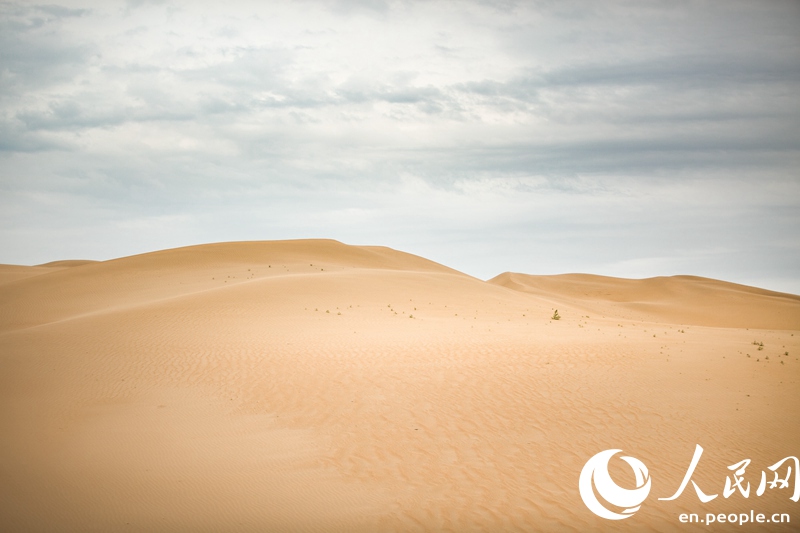
The Kubuqi Desert, the 7th largest desert in China. [Photo by Tanja Herko]
The May moon shines brightly upon Otgonhuar’s small tent. Behind her humble residence, the desert extends its reaches to the influx of tree planters, whose shadows move towards silver dunes, each carrying a sack filled with saplings. For the past two months, Otgonhuar and her 36 workers have been planting trees in the Kubuqi Desert, the seventh-largest desert in China, from dawn until midnight.
“I used to hate my hometown. Endless deserts, suffocating sandstorms, poverty-stricken villages, these were the images of Ordos just a few decades ago,” said the 46-year-old tree planter.
Meaning “palace” in Mongolian, Ordos is home to the Mausoleum of Genghis Khan (1162-1227), founder of the Mongol Empire. Its former glory was swallowed by desertification, primarily due to overgrazing. Maowusu Sandy Area, one of China’s four vast sandy areas, along with the Kubuqi Desert, account for nearly half of the land under the jurisdiction of Ordos. The once beautiful prairies where Otgonhuar’s ancestors had been living for generations were inundated with sand and rocks, while animal husbandry and farming, the traditional pillars of the local economy, gradually declined, resulting in abject poverty.
The situation started to change in the 1990s when the local authorities decided to build a 100-km highway across the desert, encircling it with trees and grass, and then tackling the sand patch by patch.
“The idea of connecting the desert to the outside world has inspired me. If a road can be built in the desert, why can’t we plant trees to restore Ordos to its former glory? With this thinking, many residents like me have embarked on a journey to make the desert greener,” said Otgonhuar.
Otgonhuar’s dream has become a reality over the past three decades, as government-led afforestation efforts, with active participation from enterprises and residents, have successfully stopped the spread of desertification and poverty. In 2016, the forest coverage rate in Ordos reached 26.7 percent. About 70 percent of Maowusu and 25 percent of the Kubuqi Desert underwent afforestation, while the green efforts also lifted about 102,000 inhabitants out of poverty.
Ordos' success has not only benefited the locals, but has also been applauded at the United Nations Convention to Combat Desertification (UNCCD). Chinese President Xi Jinping sent a congratulatory letter to the 7th Kubuqi International Desert Forum held in Ordos in July, which attracted governmental officials, experts and NGOs from 30 countries, praising the “Ordos Kubuqi mode”, calling for more international cooperation to combat desertification, as well as ensure full implementation of the 2030 Agenda for Sustainable Development.
“We’ve shown the world that even the desert can teem and reverberate with greenery, wealth and life. Ordos has provided a template for desert revival, bringing the idea of sustainable development to the world,” said Han Yufei, director of the forestry bureau of Ordos.
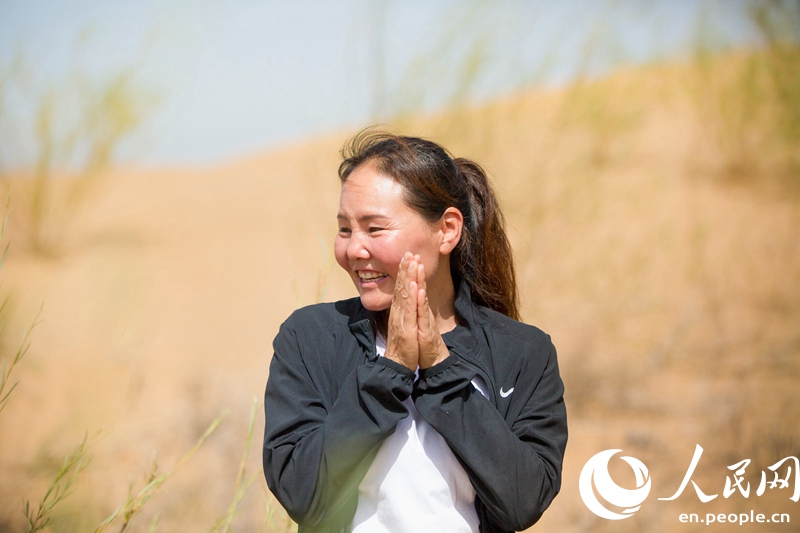
Otgonhuar’s dream has become a reality over the past three decades, as government-led afforestation efforts, with active participation from enterprises and residents, have successfully stopped the spread of desertification and poverty. [Photo by Tanja Herko]
The guardian, rose and desert
Not unnaturally in a city besieged by deserts, sandstorms used to engulf Ordos. Desertification brought air pollution and drought, making farming and grazing impossible. Clearing a path through dust and dirt was the first thing locals had to do in the morning, while sand dunes were ubiquitous in the dust-laden city, providing local kids their only entertainment — sand slides.
“The desert was a nightmare for me. When the local authorities encouraged us to plant trees in the desert, I couldn't stop laughing. How on earth could we turn a desert into an oasis? I couldn't believe it,” said Otgonhuar.
Unlike Otgonhuar, who initially had no faith in tree planting in the desert, 51-year-old Jia Wenyi, director of Sharizhao sand management station in northwest Ordos’ Hanggin Banner, along with his 35 desert rangers, have already been planting trees in Kubuqi for an entire lifetime.
“My grandfather started working at this sand management station when it was established in 1953. My father and I have inherited his mantle, hoping to build an oasis in the desert,” said Jia.
According to Jia, the local authorities started to take serious action almost 30 years ago, implementing advanced sand desertification control technologies in 1990. Ever since, he and his rangers have been helping locals to plant trees in the desert, turning sand into grassland patch by patch.
“For the past few decades, our station has offered locals free saplings and tech support. According to local policies, if you plant trees in the desert, you can own the land for 70 years. Such moves have inspired people to plant more trees in the desert,” said Jia.
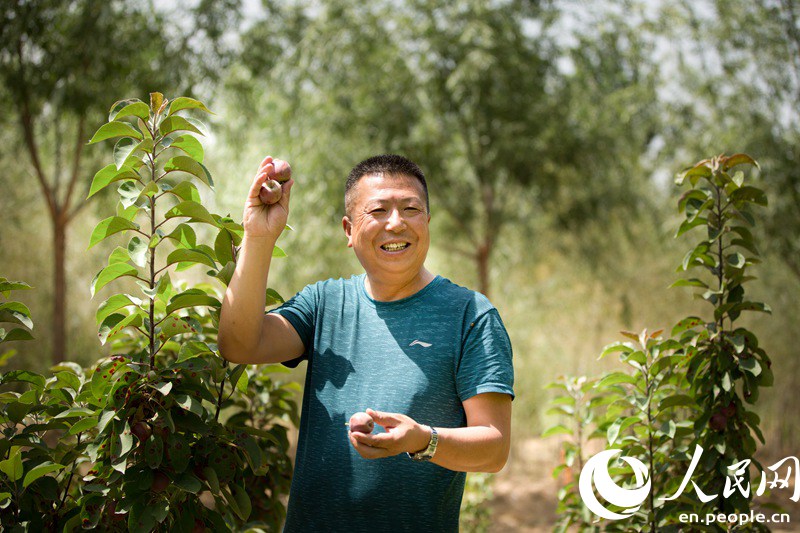
51-year-old Jia Wenyi, director of Sharizhao sand management station in northwest Ordos’ Hanggin Banner, has already been planting trees in Kubuqi for an entire lifetime. [Photo by Tanja Herko]
Government encouragement to plant trees revealed a glittering prospect for Otgonhuar, who was then working at a local bank. She quit her job, joined a construction team to plant trees on the Kubuqi highway in 1997, and finally started her own tree-planting business in 2009.
“Initially, my plan was to make money. But as time went by, I realized that planting trees is not merely a business, but also a great cause. Only by finally getting rid of the desert could we become rich and happy,” she said.
Holding on to this green dream, Otgonhuar and her team have afforested over 2,000 hectares of sandy land in Kubuqi Desert in just a decade, with a sapling survival rate of over 95 percent. Her team is now often hired by many local companies to plant trees in the desert. Under her leadership, 25 low-income workers now earn a daily wage of around 200 RMB ($29), while she earns over 200,000 RMB per year.
“Planting trees in the desert has changed my life. The improved environment has made me happier, and I want to spread this thought to all,” said Otgonhuar, who has been hailed by the locals as the “desert rose,” encouraging more women to join her cause to make the desert greener.
Echoing Otgonhuar, Jia said the local environment has dramatically improved in the past three decades. Animals like pheasants, rabbits and foxes now inhabit the newly planted grasslands, while precipitation and air quality have also improved significantly.
“Most locals have now reached a consensus to plant trees and protect the environment. For three generations, my family has been guarding the desert, and I hope my children will continue to eradicate desertification in the future,” said Jia.

The Kubuqi Desert is turning into an oasis. [Photo by Tanja Herko]
Dig the green gold
“When we first started our ecology business in the Kubuqi Desert in 1988, no one believed that we could make a profit and protect the environment at the same time. Thirty years on, we have proved that such a mission is possible,” said Hao Liangshe, director of the poverty alleviation office of Elion, a private ecology and investment enterprise.
According to Hao, his company has invested over 30 billion RMB ($5.82 billion) in the Kubuqi Desert-greening project since 1988, helping to lift about 102,000 local farmers and herdsmen like Otgonhuar out of poverty.
In addition to tree planting, the company has also encouraged local residents to plant drought-tolerant herbs such as Chinese licorice and cistanche, both profitable herbs widely used in traditional Chinese medicine. The plants help enrich the desert soil, with the bacteria around their roots generating nitrogen, which forms a biological crust above the sand that begins the fertilization process of the desert soil.
To ensure seedlings can survive the harsh environment, as well as promote sustainable ecological restoration, the company has invented and applied more than 100 environmental technologies.
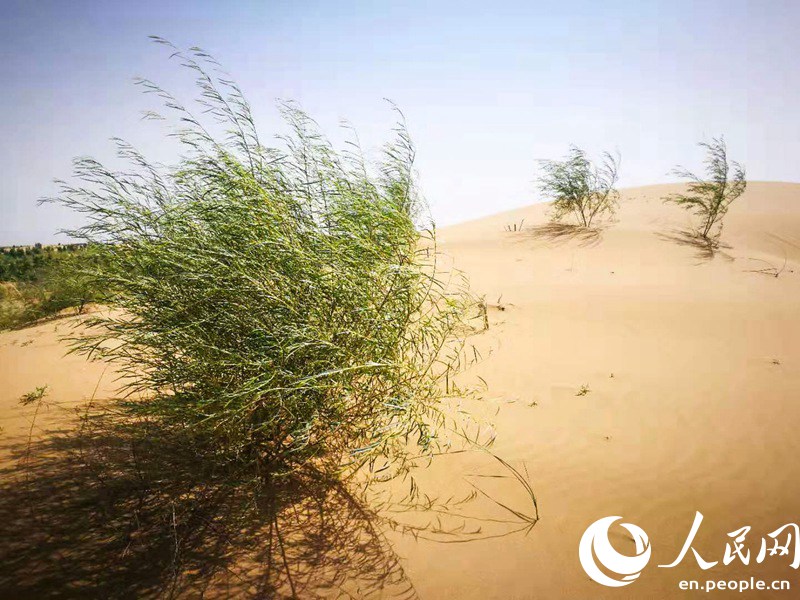
Desertification has been dealt with successfully in Ordos. [Photo by Tanja Herko]
The vast desert has also provided a space to set up solar panels, which can feed electricity into the national power grid. Desert tourism, along with the sales of herbs, have become a reliable source of income for both the residents and local enterprises, laying a solid foundation for economic and environmental sustainability.
“Desertification control has provided our company with new opportunities. Governments and companies from countries like Mongolia, Pakistan and Saudi Arabia are reaching out to us, hoping to use our technologies and experience to manage their deserts. We’ve found the green gold in the desert,” said Hao.
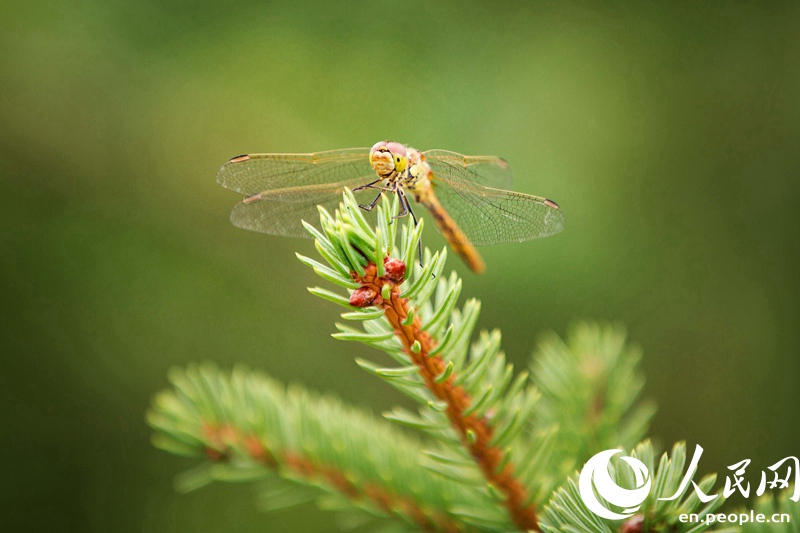
The Kubuqi Desert is turning into an oasis. [Photo by Tanja Herko]
A green name card to the world
In just 30 years, the Kubuqi Desert greening project has succeeded in not only reining in the relentless growth of the seventh-largest desert in China, roughly the size of Kuwait, it has also turned about 6,000 square kilometers of the desert - roughly one-third of it’s entire size - green.
Due to its impressive results, the Kubuqi desertification control model was named by the United Nations as a "global ecological and economic demonstration zone" in 2014, while Ordos has been host to the Kubuqi International Desert Forum every two years since 2007.
“Government policy support, the market-oriented participation of residents, as well as ecological improvement as a result of investment and new technology, have been vital to the success of the Kubuqi model,” said Hao.
Ordos’ success has attracted many politicians and experts around the world, who come to China to find a remedy for their desertification problem. Abdushukur Khudoykulovich, deputy chairman of the state forestry committee of Uzbekistan, who also joined this year’s Kubuqi International Desert Forum, noted that his country could learn from the Kubuqi model to tackle environmental issues.
“Half of Uzbekistan territory is occupied by desert zones, not to mention that the Aral Sea, which was there 30 years ago, has now been engulfed largely by deserts. We are now trying to tackle the spread of deserts. China’s experience can enlighten us more,” said Abdushukur.
“Desertification and drought are our common enemy that has threatened our social and economic development. The world should work together to tackle such issues, and I believe China has served as a great model for us all,” he added.

